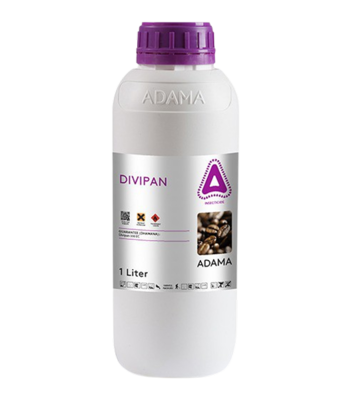Divipan 100 EC
A contact incsectice for the control of a wide range of pests in coffee

General Info
Crops
Coffee
Application Advice
Application Rates and Timing
At the onset of the first signs of infestation apply 1.5L/ha, 150ml/100L of water, 30ml/20L of water.
Resistance Management
To prevent risk of developing pest resistance, it is recommended that Divipan 100 EC be alternated with products of different modes of action.
Safety
Pre-harvest interval: 7 days.
Wear protective clothing: overalls, footwear, gloves, and face shield when preparing and using the product. Do not eat, drink or smoke while using it. Avoid inhaling spray mist, contact with skin, eyes and clothing. Do not apply upwind and stay out of the spray mist.
Divipan 100 EC is toxic to fish, bees and wildlife. Do not contaminate streams, rivers or waterways with the chemical or used packs. Do not spray when bees are foraging. Keep off livestock and wildlife away from treated areas.
First Aid Instructions
FIRST AID INSTRUCTIONS
If poisoning is suspected, contact the doctor, or Poisons Information Centre.
Skin contact: Take off clothing; wash the skin immediately with plenty of water and soap.
Eye contact: Hold the eye open and rinse thoroughly with running Water for 15 minutes.
If inhaled: Move the patient to fresh air. If the subject is not breathing, give artificial respiration, preferably mouth-to-mouth and call the doctor immediately.
If swallowed: Give copious quantities of either beaten egg white, starch solution or milk of magnesia before inducing vomiting. Repeat until vomit fluid is clear and free from the smell of poison. Never give anything by mouth to an unconscious person. Seek medical advice immediately.
TOXICOLOGICAL INFORMATION
Symptoms of poisoning: Toxic if swallowed. Weakness, headache, tightness in chest, blurred vision, salivation, sweating, nausea, vomiting, diarrhea and abnorminal cramps.
Antidote: Administer atropine sulphate intravenously 1-4mg every 5-10 minutes until signs of atropinisation occur. Or administer obidoxime chloride or palidoxime at 50mg/kg upto a total dose of 1-2g. Repeat oximes if necessary. Do not give morphine.
Note to physician/Treatment: Treat symptomatic and supportively.